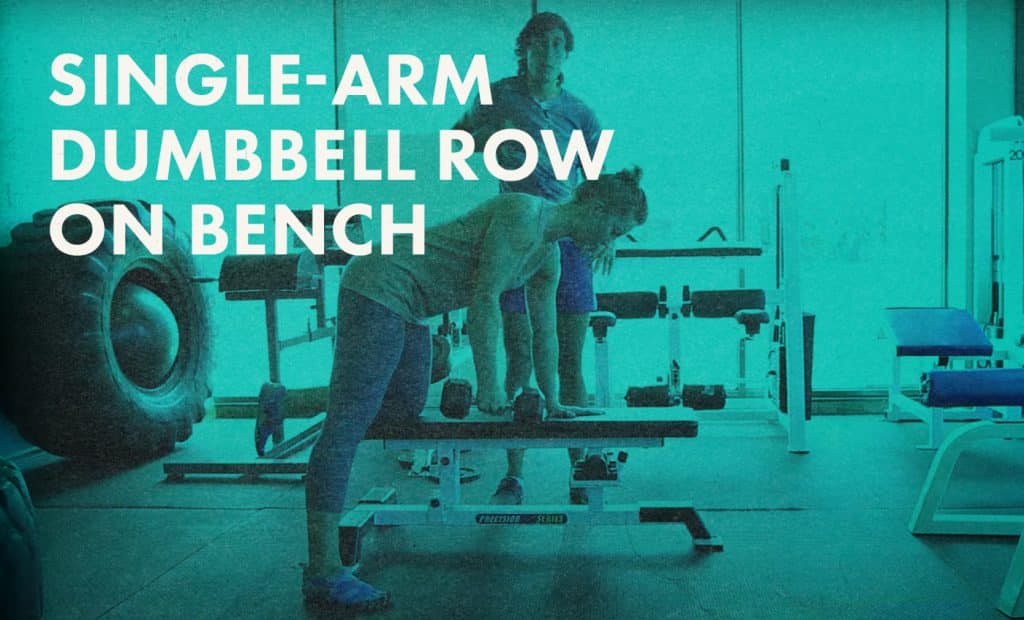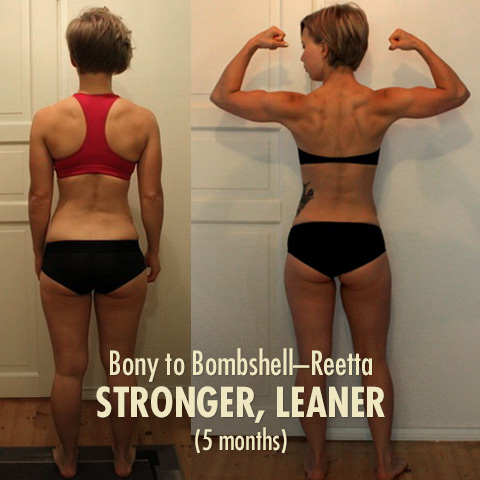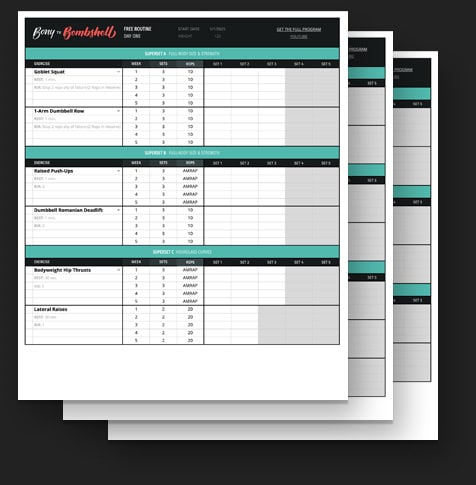
Single-Arm Dumbbell Row on Bench: Overview, How To Do It, & Tips
The single-arm (1-arm) dumbbell row on the bench is a classic lift. It’s a great beginner exercise for building muscle in your upper back. The main muscles it works are the lats, traps, and rear delts. It’s also fairly good for your arms, though, and should stimulate a bit of biceps growth. Let’s take a closer look at how to do it, common mistakes, and how to program it into your workouts.
Single-Arm Dumbbell Rows On Bench: The Overview
We use this rowing variation for our Bony to Bombshell program to get our members started. Once they get comfortable doing these rows, they can start practicing the lowered chin-up. And from there, they can transition to doing full chin-ups from a dead hang. (You can also use the cable row as a variation.)
Benefits
- Builds the upper back. This exercise is primarily for your upper back but will also give your lats, traps, and biceps a good amount of work.
- A simple variation that takes next to no time to set up, and that is easy to do. This exercise is great for beginners because it’s simple, stable, and just requires one dumbbell (or kettlebell). You can even do this exercise at home just by using your couch.
- It’s a unilateral lift. A unilateral lift is an exercise that works one side at a time, and it can be helpful for fixing imbalances. If your right or left arm is stronger, you just keep the reps the same. Over time, they’ll equal out, bringing more symmetry and balance.
- Helps to fill out the upper portion of the “hourglass curves.” Many women want wider hips, and we include plenty of lower body lifts. But if you’re a bit pear-shaped, you’ll want to include some upper body lifts in a feminine way to fill out the back and shoulders.
- Helps to develop upper body strength and independence. A lot of the women we work with want more strength to handle daily life. Whether that’s picking up a toddler or a heavy travel bag, lifting heavy groceries, or whatever else it is. The single-arm dumbbell row trains you for picking up heavy things in a safe way.

Muscles Worked
The single-arm dumbbell row on the bench primarily works the back, but it still works the shoulders and elbow joints and is a compound exercise. You might notice that even your fingers get a little sore from these ones.
- Lats. These muscles will be the star of this exercise and help the shoulders move and row the weight up. They will help with your hourglass shape.
- Rhomboids. This is an upper back muscle, a bit closer to your spine and helps to stabilize and pull the shoulders back.
- Traps. These muscles run from the middle of your back and up your neck. They will help stabilize the weight and pull your shoulders back.
To a lesser extent, the 1-arm dumbbell row on the bench will also work your biceps, rear delts (back of shoulders), forearms, and even your core muscles as your body works hard to stabilize against the dumbbell.
Single-Arm Dumbbell Row On Bench Video Demonstration
Here’s Marco coaching Marielle on how to do the 1-arm db row on the bench:
Single-Arm Dumbbell Row On Bench Proper Form Breakdown
- Grab a dumbbell with a weight that is appropriate for you.
- Go to a flat bench and place the dumbbell down on the floor.
- Place your left hand up near the top of the bench and your left knee on the bench. I like to hook my left foot at the end of the bench for stability and consistent positioning.
- Reach down with your right arm and grab the dumbbell off the floor.
- Get into a neutral position where your back is in a straight line. This is your starting position.
- Take a deep breath, then breathe out as you contract with your back, rowing the weight up, driving your elbows back, and bringing your thumbs to your armpit. You can push through your right heel on the floor for power.
- At the top of the movement, take another breath in and slowly lower the dumbbell under control as you breathe out.
- At the bottom of the movement (neutral position, you don’t need to touch the floor), that completes the rep.
- Do the amount of reps listed on your workout sheet.
- Then flip around and do the other arm. You can either roll the dumbbell under the bench to the other side, or you can keep the dumbbell on the same side and rotate your body 180 degrees on the bench and face the other way.
- Match the exact same amount of reps as you did on the previous arm.
- That’s one set.
Common Mistakes With The 1-Arm Dumbbell Row On Bench
- Not matching reps on both sides. It’s normal to want to start the set with your dominant, stronger arm. You ignore the number of reps on the workout sheet and just do as many as you can. Let’s say you get 11 reps with your right arm. Without resting much, you switch to the left side and only get 8 reps. That’s going to cause an imbalance. If you can’t gauge how many reps you can do with your strong arm, always start the set with your weak arm. Then, match those reps with your stronger arm, and over time, you’ll notice your weaker arm will catch up.
- Looking up at the mirror and kinking your neck. When you bend your head up to look at the mirror, you’re falling out of a neutral position. Keep your head down and in line with your spine.
- Choosing too heavy of a dumbbell. If the dumbbell is too heavy, you’ll have a hard time pulling the dumbbell all the way up to your chest. You’ll find yourself jerking the weight instead of controlling it. Lighten the weight and try again.
- Choosing too light of a weight. Many women underestimate their strength. If the reps feel too easy, try experimenting with going heavier and heavier until you can just barely do the reps listed on the sheet.
- Not breathing! Too many people hold their breath and bang out reps and wonder why they feel so lightheaded. At the very least, you should be doing a full breath in between reps. But we like to coach women to be breathing throughout the whole rep.
Using The Single-Arm Dumbbell Row On Bench In A Female Workout
Use A Moderate Rep Range
In research, to optimize for muscle growth and muscle size, you want to choose a weight that you can do 4–40 repetitions with. The sweet spot for the 1-arm db rows on the bench is in the lower rep range of around 8-10 reps. The reason why is because you’ll need to repeat these reps on the other side. If you’re doing 15 reps, you’ll need to repeat that on the other side, and you might exhaust yourself too much. We’re not trying to do cardio. And if you lift too heavy, you’ll find yourself getting sloppy with the form.
If you find yourself not able to do at least 7 reps, use a lighter weight. If you can do more than 12 repetitions, use a heavier weight. That will guarantee that the workout is helping you gain both muscle size and muscle strength and not making endurance adaptations.
Challenge Yourself, But Stop Shy Of Failure
Ideally, you’ll stop your 1-arm db rows when you’re just about to fail, but you could still do a couple of reps more. But if you’re a beginner, it’s hard to know exactly how hard you’re pushing yourself. Err on the side of lifting too light, and if it’s too light, count it as a warm-up. Keep working up, and you’ll know when the weight is right for your goal reps.
Start With Two Sets, and Add More When Needed
Start with just a couple of sets, then over time, add more sets as you get stronger. We recommend doing two sets in the first week. Practice your form, find the right weights, and take your time learning the rowing motion.
Next week, if your back, biceps, and fingers aren’t too sore at the start of each workout, try adding a set to each exercise. If that goes well and you feel ready for more, add another set next week. You can do around 3–6 sets per exercise. Most women will do best with 3–4 sets. If you ever start to feel worn down, or if you’re coming back after a long break, start the cycle over again, going back to just two sets and rebuilding from there.
Rest 1-2 Minutes Between Sets
How long you rest between sets of rows isn’t that important. Whether you rest for 1 minute or 10 minutes, you’ll still stimulate a similar amount of growth. The important thing is that you rest long enough to catch your breath, ensuring that your cardiovascular system doesn’t limit the performance of your muscles.
We want to challenge your back muscles—not just your heart (though your heart will get a good workout, too!)
The main reason to rest for just a couple of minutes is to keep your workouts shorter. You don’t want to spend all day in the gym. But if you need more rest or get interrupted partway through your workout, no problem. Just pick up where you left off.
If you want to blast through your workout even faster, you can do the lifts in a circuit/superset. Do a set of 1-arm db rows, rest a minute, then do a set of push-ups, rest a minute, then do your second set of 1-arm db rows, and then do your second set of push-ups. That way, you’re still giving different muscle groups plenty of time to recover between sets, but you’re doing another exercise during the rest period.
Free Routine For Female Beginners: Full Body Workout That Includes The Single-Arm Dumbbell Row On Bench
If you don’t have a workout, you might be interested in our full Bony to Bombshell program. A sample beginner’s workout for women that includes db sumo deadlifts could look like this:
- Goblet Squats: 2 sets of 10 repetitions.
- Dumbbell Sumo Deadlift: 2 sets of 10 repetitions.
- Raised Push-Ups: 2 sets of as many reps as you can.
- 1-Arm Dumbbell Row On Bench: 2 sets of 10 repetitions.
- Lateral Raises: 2 sets of 10 repetitions.
- Bonus Glute Work: 2 sets of glute bridges or hip thrusts
GET THE GOOGLE SPREADSHEET OF THE
FREE BEGINNER’S FULL-BODY WORKOUT For Women

Get the workout as a Google spreadsheet. You’ll be able to pick from exercise alternatives, fill out the sheet, and get our beginner’s warm-up.
Plus, we’ll make sure you’re on the Bony to Bombshell newsletter, and send you all of our best women's muscle-building content.
What Next?
If you liked this article, you’d love our muscle-building newsletter. We’ll keep you up to date on all the latest muscle-building information for women. Or, if you want us to walk you through the process of building muscle, including teaching you the lifts, giving you a full workout program, a complete diet guide, a recipe book, and online coaching, check out our Bony to Bombshell Program.



FREE women's Muscle Growth MINI-COURSE
Get our 5-part female bulking mini-course that covers everything you need to know about:
Here are some related articles